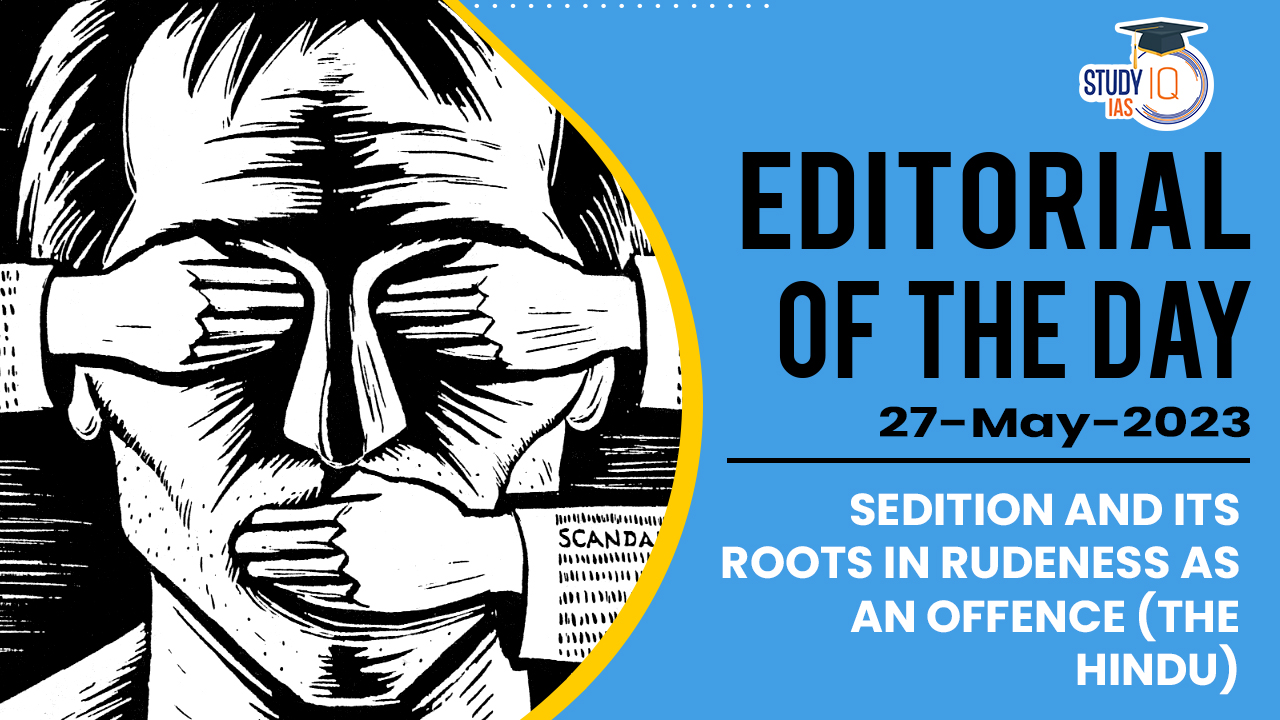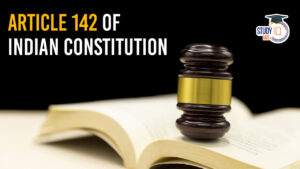Table of Contents
Context: The article is discussing the similarities between the law of sedition and other provisions that criminalize speech in different countries. It mentions the annulment of the offence of sedition in the Pakistan Penal Code by the Lahore High Court this year. While at the same time, it highlights the situation in India, where the police registered complaints and arrested individuals, including printing press owners, for posting anti-government posters. It mentions that instead of charging them with sedition, they were booked for criminal conspiracy to cause public mischief and deface public property, possibly under provisions of the Press and Registration of Books Act, 1867. The article highlights that while sedition laws may be under scrutiny, similar provisions that restrict freedom of speech continue to exist in other forms. It suggests that even though the offence of sedition might be removed, its underlying logic can be found in other laws that criminalize certain types of speech or expression.
Sedition and its Roots in Rudeness as an Offence Background
What is Sedition?
- Sedition under IPC 124A is defined as an attempt to bring in hatred or contempt, or excites or attempts to excite disaffection towards the government established according to the law.
- The expression “disaffection” includes disloyalty and all feelings of enmity;
- Comments expressing disapprobation of Government measures with a view to obtain their alteration by lawful means, without exciting hatred, contempt or disaffection, will not constitute an offence under this section;
- Comments expressing disapprobation of the administrative or Government action without exciting hatred, contempt or disaffection, will not constitute an offence under this section.
- Sedition was included as an offence in 1890 under section 124A IPC through the Special Act XVII.
- Punishment:
- It is a non-bailable law that is punishable with imprisonment from three years up to life, along with a fine.
- Individuals charged under the law will be barred from a government job and their passport is seized by the government.
- Origin of sedition law:
- Sedition comes under Section 124A Indian Penal Code (IPC). The law was drafted by British historian-politician Thomas Babington Macaulay in 1837.
- The British colonial government used the law to primarily suppress the writings and speeches of prominent Indian freedom fighters.
- Mahatma Gandhi, Lokmanya Tilak, and Jogendra Chandra Bose were some of the leaders who were charged under the law, for questioning colonial administration.
- During process of constitution framing, the sedition law was opposed by members of Constitutional Assembly, such as K.M. Munshi, who argued that such a draconian law is a threat to democracy in India.
- The word sedition was omitted from the Constitution due to the persistent efforts of Bhupinder Singh Mann.

Stats IQ: Sedition cases in India:
- NCRB data shows that sedition cases have risen from 47 in 2014 to 93 in 2019, a massive growth of 163 percent.
- Conviction rate: The conversion rate from cases to conviction is a mere 3 percent.
- Highest cases: Assam (76), Haryana (42 cases), Jharkhand (40), Karnataka (38), Andhra Pradesh (32) and Jammu and Kashmir (29).
- These states accounted for more than half the number of total sedition cases recorded in the country.
- Substantial cases: Manipur (28), Uttar Pradesh (27), Bihar (25), Kerala (25), Nagaland (17), Delhi (13), Himachal Pradesh (12), Rajasthan (12) and West Bengal (12) registered cases in double digits.
- Zero cases: Meghalaya, Mizoram, Andaman and Nicobar Islands, Chandigarh, Dadra and Nagar Haveli and Daman and Diu, and Puducherry did not register any sedition cases.
Decoding the Editorial
The article delves into the complex interplay between sedition laws, freedom of speech, power dynamics, and social hierarchies, emphasizing how these factors shape the perception and prosecution of speech offences.
- The law of sedition: The article compares the law of sedition in Pakistan (which was struck down) and Section 124A in India, both of which criminalize speech that brings hatred, contempt, or disaffection towards the government.
- While sedition laws might be under scrutiny, the underlying logic of stifling dissent and demanding reverence for established ideas remains prevalent.
- Transplanting of sedition logic: The article argues that the logic of sedition has permeated into other provisions of law that criminalize speech.
- It points to examples such as blasphemy laws in Pakistan, which are used against the poorest citizens, and the notion of “hurting sentiments” in India.
- The author suggests that while sedition may be challenged, similar restrictions on speech persist under different names.
- Social hierarchy and badtameezi: The article discusses how the perception of offensive or disruptive speech is often influenced by social hierarchies.
- It mentions that traditionally, ill-mannered or offensive speech is seen in terms of who is speaking and to whom.
- Power dynamics play a role, where those challenging established power structures are more likely to face prosecution.
- Power dynamics and law: The article highlights the relationship between power, courtesy, and the use of law.
- It suggests that state officials, including the police, are seen as occupying a higher position in the social hierarchy, which affects encounters with citizens.
- The author argues that law enforcement often mirrors social and political power, and prosecutions for speech offences tend to target those challenging the dominant narratives.
- Speech offences and hierarchy: The article points out that the prosecution of speech offences tends to focus on content that challenges political or social power.
- Offences are framed against those deemed inferior in established hierarchies or outsiders to the prevailing narrative.
- The author suggests that the enforcement of law reflects the intertwined relationship between law and society, where certain statements are prosecuted while others are tolerated or go unmediated, revealing inconsistencies and power dynamics.
Evaluation of Supreme Court Judgement:
The article discusses the significance of the recent judgement by the Supreme Court in the Media One case, which addresses the logic of sedition and its evolving nature.
- The court struck down the Ministry of Information and Broadcasting’s decision to not renew the broadcast licence for the channel on the grounds of being “anti-establishment” and a threat to national security.
- The court’s judgement emphasizes that critical views expressed by Media One regarding government policies cannot be automatically labelled as anti-establishment.
- It states that expecting the press to unquestioningly support the establishment itself undermines the concept of a free press.
- The court further highlights that denying security clearance based on a media channel’s constitutionally entitled views creates a chilling effect on freedom of speech and press freedom.
- The judgement also criticizes the state’s casual use of “national security” as a catchphrase to censor speech. It asserts that such claims cannot be made without sufficient evidence or as a pretext to deny citizens their lawful remedies. The court emphasizes that using national security in this manner is incompatible with the rule of law.
- The significance of this judgement extends beyond the mere striking down of Section 124A (sedition law). It highlights the importance of an ongoing engagement and dialogue regarding the mutating and resettling logic of sedition laws.
By challenging the misuse of national security concerns and affirming the importance of press freedom, the court’s judgement contributes to the evolving understanding of sedition laws and their impact on democracy.
Beyond the Editorial
Judicial opinion on sedition law:
- The Supreme Court in Romesh Thapar vs. State of Madras (1950) held that criticism of the government exciting disaffection or bad feelings towards it cannot be regarded as a justifying ground for restricting the freedom of expression and of the press.
- In Gopi Chand vs. The State (1951), and Ram Nandan vs. State of Uttar Pradesh (1959), courts declared that Section 124A of the IPC was unconstitutional.
- The Supreme Court in Kedar Nath Singh vs State of Bihar (1962) gave constitutional validity to sedition law.
- The court however said that unless accompanied by an incitement or call for violence, criticism of the government should not be called sedition.
- In Balwant Singh vs. State of Punjab (1995), the Supreme Court said that the real intent of the speech must be taken into account before labeling it seditious.
- In Rajat Sharma vs. the Union of India Case, 2021, the court ruled that disagreeing with the views and policies of the government will not be considered sedition.
- In Disha Ravi case, the Delhi High Court ruled that government cannot imprison citizens because of disagreeing with the state policies.
- In Farooq Abdullah case, the judiciary observed that expression of views of dissent, which is different from the opinion of the government, cannot be termed seditious.
Criticism of sedition law:
- Violation of freedom of speech: Fundamental Right of freedom of speech is violated by the sedition law. This is considered a threat to democracy.
- Poorly defined: Assessing the exact nature of speech that can be considered sedition is very difficult due to the poor definition of the law. Distinguishing genuine expression of speech from seditious speech will be challenging.
- Misuse: There have been numerous instances where governments have misused the sedition law to curb dissent. Political opponents, journalists, social activists etc have been victims of the sedition law.
- Colonial legacy: Sedition law is a colonial legacy, which was used mainly to overcome popular movement. It is thus appropriate to give up this colonial burden.
- Regular invoking: Sedition law was supposed to be an extraordinary instrument that was to be used only when security and sovereignty of the country is threatened. However, it is invoked quite regularly, even on flimsy grounds.
- Low conviction: The conviction rate of sedition law is about 3%. This shows that the law is mainly used to create fear and silence any criticisms or dissent.
Support for sedition law:
- Territorial integrity: The law will help in tackling anti-national, secessionist and terrorist elements that threaten territorial integrity of the nation.
- Reasonable restriction: The Constitution allows reasonable restriction on freedom of speech and expression. This does not violate the fundamental rights.
- Stabilizing state: The sedition law protects the elected government from attempts to overthrow it using violence and illegal means.
Way Forward
- Democracy requires active participation of citizens in decision making process, including constructive criticisms of government policies.
- Sedition law has empowered the executive to use this ambiguous provision as an instrument to regulate public opinion and indiscriminately wield power.
- The need of the hour is to review this draconian law. Even if the law is not completely abolished, there has to be checks and balances imposed so as to reduce the misuse.


 Serious Fraud Investigation Office (SFIO...
Serious Fraud Investigation Office (SFIO...
 Article 142 of Indian Constitution, Sign...
Article 142 of Indian Constitution, Sign...
 Pakistan-Occupied Kashmir (PoK): History...
Pakistan-Occupied Kashmir (PoK): History...





















